
Stevia (Stevia rebaudiana) is gaining popularity in the Philippines as a plant-based natural sweetener that offers a healthy alternative to sugar. While it may still sound unfamiliar to many Filipinos, this herb has long been used in countries like Paraguay, Brazil, Japan, and China. In 2025, it’s finding a new audience among health-conscious consumers, diabetic individuals, and wellness-driven industries.
Stevia is cultivated for its leaves, which contain steviol glycosides—the compounds responsible for its remarkable sweetness. Crude stevia leaves are 10–15 times sweeter than sugar, while purified extracts such as stevioside and rebaudioside A are up to 300 times sweeter than table sugar.
Health Benefits of Stevia
It is not only a low-calorie sweetener, but also a functional food with several health benefits backed by recent studies:
- Diabetic-friendly: Does not spike blood sugar levels
- Anti-obesity: Zero-calorie property helps in weight control
- Heart-healthy: May reduce blood pressure in hypertensive patients
- Dental protection: Does not promote tooth decay
- Skin health: Contains antioxidants that may promote clearer skin
According to updated literature and a 2023 FAO/WHO Joint Expert Committee on Food Additives (JECFA) report, rebaudioside A and stevioside are confirmed to be non-toxic, non-mutagenic, and safe for long-term consumption, provided intake does not exceed the acceptable daily intake (ADI) of 4 mg/kg body weight (expressed as steviol equivalents).
Stevia’s Global and Local Acceptability in 2025
Global Status
Since 2008, regulatory agencies such as the U.S. FDA, European Food Safety Authority (EFSA), Japan’s Ministry of Health, and Health Canada have recognized high-purity steviol glycosides as Generally Recognized as Safe (GRAS).
As of 2025:
- Over 120 countries have approved stevia for food and beverage use
- Major global food corporations (e.g., Coca-Cola, PepsiCo, Nestlé) use stevia in sugar-free products
- Asia-Pacific, led by China and India, remains the largest production and export zone
In the Philippines
While still considered a niche crop, it is gaining recognition among:
- Organic and herbal medicine advocates
- Local manufacturers of diabetic-friendly food products
- Health-conscious consumers seeking sugar alternatives
The Department of Agriculture (DA) and Department of Science and Technology (DOST) have endorsed stevia as a potential high-value crop under their Plant Industry Development Framework 2025.
Stevia Market Trends and Demand Forecast (2025)
Global market value for stevia-based sweeteners is expected to reach $1.5 billion in 2025, with an average CAGR of 8.9%. Mintel and Statista report that 20–25% of sugar substitutes in food and beverages now contain stevia, driven by rising health awareness and diabetes rates.
China remains the largest global producer of stevia leaves and extracts, followed by Paraguay and India. In the Philippines, production remains small-scale but is expanding due to:
- Increasing import substitution efforts
- Inclusion in integrated organic farming systems
- Growing demand for local, natural sweeteners in wellness brands
Local Initiatives: Growing Stevia in the Philippines
The Bureau of Agricultural Research (BAR) continues to support stevia farming through pilot projects and farmer education programs. One notable initiative is led by the Bicolandia Greenfields Development Organization in Naga City, under the guidance of Dr. Ma. Elena F. Quimio, Ph.D.
Key milestones of the project:
- Establishment of nurseries for propagation
- Distribution of planting materials to farmer-cooperators
- Training in Good Agricultural Practices (GAP) for stevia production
- Field evaluations for adaptability in tropical microclimates
In 2024, BAR announced that stevia has shown high adaptability to Philippine soil and climate, especially in upland and moderately sloped terrains.
Agri-Business Opportunity: Why Farmers Should Consider Stevia in 2025
Beyond its health and market benefits, it offers unique advantages for Filipino farmers:
1. Profitability
- Dried stevia leaves retail between ₱2,500 to ₱3,000 per kilogram in niche markets
- One hectare can yield up to 2.5–3 tons/year of dry leaves with proper care
2. Low Input Cost
- Minimal pesticide use due to its natural pest-repelling properties
- Can be cultivated alongside herbs, root crops, or organic vegetables
3. Export Potential
- High demand for locally sourced natural sweeteners by international wellness brands
- Opportunity to develop value-added products (e.g., stevia tea, powder, drops)
4. Sustainability
- Drought-tolerant and adaptable to various Philippine agro-climates
- Grows best in well-drained loamy soils under full sun
- Ready for harvesting 3–4 months after planting, with multiple harvest cycles yearly
Challenges and Future Outlook
While the prospects are strong, widespread stevia adoption in the Philippines still faces hurdles:
- Limited awareness among consumers and food processors
- Lack of established post-harvest facilities and value chain systems
- Regulatory clarity needed for large-scale commercialization
However, with ongoing support from DA, DOST-PCAARRD, and private agri-entrepreneurs, stevia could become a flagship herbal crop in the Philippines by 2030.


This is good..we will contact your group to provide us the seedlings to use.